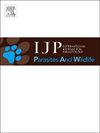The epidemiology of a novel Leucocytozoon parasite in an endangered population of marbled murrelets (Brachyramphus marmoratus) on the Oregon coast
IF 2.2
3区 医学
Q3 ECOLOGY
International Journal for Parasitology-Parasites and Wildlife
Pub Date : 2025-05-07
DOI:10.1016/j.ijppaw.2025.101078
引用次数: 0
Abstract
Parasitism is a known cause of morbidity and mortality in wildlife species and may exacerbate population declines in species threatened by changing landscapes. The marbled murrelet (Brachyramphus marmoratus) is an unusual seabird that forages in the ocean but uses trees in old growth and late successional forests for nesting. Populations have declined in some areas due to both changing ocean conditions and reduction in breeding habitat, making it important to consider the impacts of other factors, such as parasites and pathogens, on murrelet health and reproduction. In this study we describe a novel blood parasite (Leucocytozoon marmoratus sp. nov.) found in a murrelet population on the Oregon coast, USA and quantify its prevalence and burden in 374 individuals along the Oregon coast over a 6-year period. Genetic sequencing revealed that the species of Leucocytozoon we identified has a mitochondrial lineage most closely related to a Leucocytozoon found in yellow-eyed penguins (Megadyptes antipodes) of New Zealand. The prevalence of Leucocytozoon in murrelets was 62 % (233/374) and within an infected individual the mean burden of parasitism was 7.1 parasites/100 white blood cells, with substantial variation between individuals (from 1 to 113 parasites/100 white blood cells). Both parasite prevalence and burden varied across years and were higher in years of poorer ocean conditions suggesting that birds experiencing poor conditions may have had reduced ability to fight infection. Male murrelets had significantly lower parasite burdens than females, which may be due to energetic constraints of egg production in breeding females. Importantly, murrelets that did not attempt a nest were associated with higher parasite burdens at the time of capture, perhaps due to correlations between parasitism and systemic health.

俄勒冈海岸濒危大理石纹小鱼(Brachyramphus marmoratus)种群中一种新型白细胞寄生虫的流行病学研究
寄生是野生动物发病率和死亡率的一个已知原因,并可能加剧受景观变化威胁的物种的种群下降。大理石纹小燕子(Brachyramphus marmoratus)是一种不寻常的海鸟,它在海洋中觅食,但在年老的树木和晚期演替森林中筑巢。由于海洋条件的变化和繁殖栖息地的减少,一些地区的种群数量下降,因此必须考虑诸如寄生虫和病原体等其他因素对小海鱼健康和繁殖的影响。在这项研究中,我们描述了在美国俄勒冈海岸的一个小海鼠种群中发现的一种新的血液寄生虫(marmoratus Leucocytozoon sp. 11 .),并在6年的时间里量化了俄勒冈海岸374个个体的患病率和负担。基因测序显示,我们鉴定的Leucocytozoon物种具有与新西兰黄眼企鹅(Megadyptes antipodes)中发现的Leucocytozoon最密切相关的线粒体谱系。小鱼中白细胞的患病率为62%(233/374),感染个体的平均寄生负担为7.1个/100个白细胞,个体间差异很大(从1到113个/100个白细胞)。寄生虫的流行率和负担在不同年份有所不同,在海洋条件较差的年份更高,这表明经历恶劣环境的鸟类可能会降低抗感染的能力。雄小海鼠的寄生负荷明显低于雌小海鼠,这可能是由于繁殖雌小海鼠产蛋的能量限制所致。重要的是,不尝试筑巢的小海鼠在捕获时的寄生虫负担较高,这可能是由于寄生与全身健康之间的相关性。
本文章由计算机程序翻译,如有差异,请以英文原文为准。
求助全文
约1分钟内获得全文
求助全文
来源期刊

International Journal for Parasitology-Parasites and Wildlife
Medicine-Infectious Diseases
CiteScore
3.80
自引率
5.60%
发文量
113
审稿时长
45 days
期刊介绍:
The International Journal for Parasitology: Parasites and Wildlife (IJP-PAW) publishes the results of original research on parasites of all wildlife, invertebrate and vertebrate. This includes free-ranging, wild populations, as well as captive wildlife, semi-domesticated species (e.g. reindeer) and farmed populations of recently domesticated or wild-captured species (e.g. cultured fishes). Articles on all aspects of wildlife parasitology are welcomed including taxonomy, biodiversity and distribution, ecology and epidemiology, population biology and host-parasite relationships. The impact of parasites on the health and conservation of wildlife is seen as an important area covered by the journal especially the potential role of environmental factors, for example climate. Also important to the journal is ''one health'' and the nature of interactions between wildlife, people and domestic animals, including disease emergence and zoonoses.
 求助内容:
求助内容: 应助结果提醒方式:
应助结果提醒方式:


